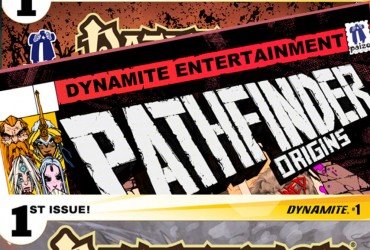Welcome to Guidance, Private Sanctuary’s source for tips and techniques for the Pathfinder Roleplaying Game, written by Everyman Gamer Alexander Augunas. Today, we’re going to be talking about bread crumbing.
We talked several months ago about the concept of railroading and why many players don’t like it. For a quick refresher, railroading is placing players on a path that they have absolutely no control over. It is essentially telling the PCs exactly what to do, what to see, and how to act at all times, as if the PCs were locked on a train looking at all of the cool sights that your train passes by before moving on to the next location. Generally speaking, railroading is a poor idea because it removes player interest in whatever it is you are showing them.
But as sensible GMs, we know that it isn’t feasible to have something prepared for every little action that the players might take. After all, we can’t peak into their brains and hope to know exactly what each of them will want to do. So how do we plan an open-world experience without omnipotence? By bread crumbing.
What is Bread Crumbing?
Just like in the above picture of James Woods following a trail of candy, bread crumbs in essence are a navigational tool for players to “follow” throughout your campaign world. The term “bread crumbing” comes from an old German folktale of all places, a famous one entitled “Hansel and Gretel.” In this folk tale, two children are essentially abandoned in the woods by their parents, but unbeknownst to their wicked mother, the kids ingeniously leave crumbs of bread on the forest ground, which they follow back home after escaping from a wicked witch. Aren’t they lucky that none of the forest critters was hungry that day!
Now, of course, we’re not following a trail of crumbs home, but rather on an adventure. In this case, “bread crumbs” refers to an unobvious trail that one can unwittingly follow to a specific location. The term “bread crumbs” is used because bread is edible and there are stories of animals following trails of bread because the bread represents a positive stimulus for the animal (i.e. “eating the bread”). Usually there’s something undesirable to be found at the end of the trail, as demonstrated by James Woods below.

When used correctly, PCs are too focused on the breadcrumbs to notice that they’ve wandered into your trap.
In the case of us as GMs, the “undesirable” thing at the end of the trail of bread crumbs is whatever scene or location that we want our players to experience, the thing that we planned for. Essentially, the breadcrumb technique is used in roleplaying games to give players something that they want, the “bread crumbs,” to trick them into doing what the GMs want them to do, because as we’ve seen in our discussion of the railroading technique, players do not want their GM deciding for them what they will be doing. The breadcrumb technique is a way to make them want what you want so you can trap them in your storyline.
Making Effective Breadcrumbs
Implementation of the breadcrumb technique is ridiculously simple, but it relies on one, major contingency: the taste-to-danger ratio. This is the quintessential risk to reward factor, how great is the reward that you’re offering compared to the risk involved? If the use of the breadcrumb technique is simple, it is the mastery of this concept that is the most difficult aspect of the breadcrumb technique because every player has his or her own “threshold” for risk to reward.
For example, as a player I am ridiculously easy to breadcrumb on most of my characters. I’m interested in what is going on in the world and while most of my characters are cautious, I tend to prefer curious characters that are willing to take big risks in order to gain big rewards. My brother, on the other hand, is significantly more cautious than I am. He takes significant goading with a near impossibly valuable treasure in order to push him towards even the slightest hint of danger.
Why this happens differs from player to player. For myself, I am a competent, experienced player who is more interested in doing cool stuff than sitting around worrying about things. My brother is less experienced and tends to become extremely attached to his characters quickly, so he is reluctant to put his characters into harms way and often needs a party member to help coerce him into dangerous situations. Ultimately, knowing your players and what they’d be willing to risk is pivotal to learning how to lead them along your breadcrumb trail.
Of equal importance is learning the player’s character. It is nice to know a player’s personal gaming style, how likely they are to go along with your plans, and so on, but many players are more than willing to put those preferences aside in order to effectively play their character. For example, if I had choose to play a very reclusive, tactical character it would be less likely that I would play impulsively as I sometimes do by default. It is also much easier to bait PCs as opposed to their players because you are more familiar with how the player acts while controlling the character and the player is more likely to tell you what the PC values as opposed to what the player himself or herself prefers.
Steps to Building a Perfect Trail
In summary, here are the two big questions that you should keep in mind when attempting to bait your PCs into following your plans:
- What is the PC working towards? Make sure your rewards are something that the character actually needs, wants, or values. For example, a paladin who opposes slavery is going to find it hard to resist word of a slave smuggling operation, even if the player knows that it is likely to be dangerous.
- What is the player working towards? What sort of character progression or story is the player working towards for his character? Providing hints of rewards that your player is interested in will help motivate him or her into following your breadcrumbs.
And that’s all that I have to say about breadcrumbing for the time being. What do you think? Have you ever pulled off a successful breadcrumb trail? What strategies did you use to do so? Has it ever failed spectacularly? Leave your answers and comments below, and come back next week for another installment of Iconic Design!
Alexander “Alex” Augunas has been playing roleplaying games since 2007, which isn’t nearly as long as 90% of his colleagues. Alexander is an active freelancer for the Pathfinder Roleplaying Game and is best known as the author of the Pact Magic Unbound series by Radiance House. Alex is the owner of Everyman Gaming, LLC and is often stylized as the Everyman Gamer in honor of Guidance’s original home. Alex’s favorite color is blue, his favorite Pathfinder Race/Class combination is kitsune gingerbread fox.








I use breadcoming, it’s pretty easy for me because my group tends to elect a ‘party leader’ to handle a lot of decisions. One of my players is almost always party leader, and one of his traits nearly all of his characters possess, is greed. Pretty easy to get him to do things by just offering riches, and then he does the rest of the work for me.
Breadcoming can easily be used with items the party is searching for. For example, say the fighter is looking for a +1 Flaming Sword, but they can’t find any for sale in the town. However, the merchant pipes up with a rumor, “Some adventuring party came through about 2 moons ago and I seen something like that on one of their guys. Headed up to the old mine to wipe out the goblins that’ve been plaguing us for the last year. Only one member came back and she’s still healing in the temple. Body works fine, but her bravery has abandoned her; become right terrified of her own shadow she has.”
So if the group goes up to get the sword and kill the goblins, they get experience, the sword for the fighter (for free, even) and even more loot. As the GM, you can then plant the seed for furthering the story with a clue, mcguffin or some other plot device there. Or even use it as an excuse to set up a retaliation on the PCs, via an attack, a murder, or kidnapping, which forces the PCs to seek revenge, leading down another plot thread.
And it all started because ol’Jack over there wanted a shiny new sword…